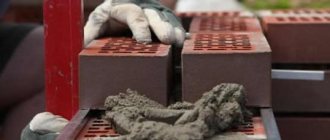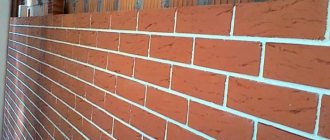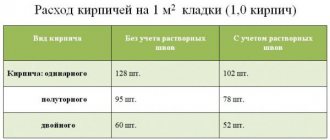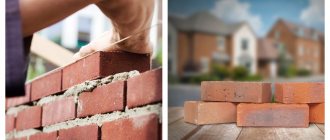Water is life on Earth. It nourishes the soil, giving life to plants. Thanks to the capillary effect, moisture rises to the topmost leaf of the tallest tree and penetrates into the very depths of brick and concrete. Gives life and destroys matter. Nature has learned to defend itself by dropping leaves and stopping the flow of fluid through the “veins.” Brick, unfortunately, still gets wet in the rain and suffers all the hardships in the severe frost.
Let's protect our favorite brick from water and mold! And for this, it will delight us for many (very long) years with its beautiful appearance and constant strength.
General information about water repellents
A water repellent is a solution that gives the surface being treated low adhesive properties with water molecules (blocks the capillary effect). Let me explain.
Wood, concrete, brick, stone are porous building materials. When water gets inside, it saturates the surface and goes deep into the substance. When freezing occurs, the H2O crystal lattice expands and, as a result, gradual destruction occurs.
Hydrophobic solutions “lined” the treated surface with a thickness of one microparticle, preventing wetting (the well-known “Teflon”). Water molecules collect in drops and, under the influence of gravity, roll down from a vertical plane.
There are 2 ways to combat capillary phenomena in construction:
- Protect the surfaces of concrete, brick and wooden buildings from moisture with other materials (insulation, vapor and waterproofing insulators).
- Treat with a special penetrating compound - a water repellent.
Which water repellent to choose
The compositions of this series are produced by domestic and Western companies; accordingly, they differ not only in price, but also in technical properties. The range of products on the Russian market is very diverse.
Inexperienced consumers may have difficulty choosing the right products. Here is a list of the best manufacturers that are in consistently high demand among builders and finishers.
- Tiprom. A series of water repellents with waterproof and antiseptic effects. The manufacturer offers three groups of products that differ in the level of protection.
- Bionic MBO . This is a water-based product with the addition of polymer fluorocarbons. It does not contain active chemical components, so the material is absolutely safe from an environmental point of view. The solution can be applied to facades made of brick, porcelain stoneware and ceramic tiles.
- NEOMID H20 STOP . A domestic product that protects against damp environments, prevents the appearance of dirt on building facades and corrosive changes, and helps get rid of efflorescence. It is made on the basis of silicon and organic compounds, safe for human health and pets.
- DALI HYDROSTOP. A universal solution used for treating facades, foundations, and interior spaces. The composition is made on a mineral basis, suitable for artificial stone, brick and concrete, increases the frost resistance of the base.
- CAPAROL DISBOXAN 450 . The concentrated substance is diluted with water in a ratio of 1:4 . Suitable for brick and concrete bases, used for treating surfaces plastered with mineral compounds. After application, frost resistance and antiseptic properties increase. Has a slight odor.
- HYDROREP . A highly effective product that provides reliable protection of the facade from the negative influence of a humid environment. The solution does not require preparation or dilution and is ready for use immediately after purchase. It belongs to the category of toxic substances; if it enters the respiratory tract, it can cause harm to the lungs.
- GOOD MASTER. Deep penetration composition that fills pores to a depth of 3 cm . After application, an indelible protective film is formed, the color of the base does not change.
In addition, the compositions produced by Penta and REMMERS performed well.
The need to use water repellents for bricks
Brick is an environmentally friendly, breathable, durable, beautiful building material. “Breathing” is provided by the number of pores in the body. When they get wet, they fill with water. Moisture frozen in the pores slowly but surely destroys the stones.
The water repellent does not fill the pores, but forms a thin film on the surface of the substances, preventing them from filling with water. That is why such a property of brick as vapor permeability is preserved.
To assess the seriousness of the harmful effects of water, Table No. 1 shows such characteristics of building materials as water absorption. And the higher it is, the lower the strength of the product.
Table No. 1. Water absorption of building materials by weight, %
| Ceramic brick: | private | 12..16 |
| facial | 8..10 | |
| Silicate brick: | private | 6..16 |
| facial | 6..14 | |
| Clinker brick | 3..5 | |
| Tree | 23..30 | |
| Concrete | 4..8 | |
| Aerated concrete | 25 | |
| Foam concrete | 10..16 | |
Types of mortar: how to impregnate brick?
Penetrating waterproofing of brickwork is divided into several types based on its composition, among which the most common is water-repellent impregnation or a water-repellent agent for silicon-organic compounds. It does not prevent the brick from “breathing”, while performing the main function of protecting against moisture. Other types of solution:
- water-based silicone impregnation;
- acrylic one-component solution;
- construction varnishes that leave a glossy shine on the surface.
Return to contents
Covering for “wet” brick
Impregnation for bricks with a wet effect, which includes silicone, helps not only protect the material from moisture, but also facilitates easy cleaning of walls from dirt, makes them brighter, reveals paint and texture. After impregnating facing or sand-lime brick with such a solution, the walls acquire moisture-resistant properties and also obtain the effect of “wet” stone. This coating looks wet and fresh, like after rain, but in reality remains dry and clean. Processing of decorative stone is especially popular.
Characteristics of Knauf construction oil
For processing ceramic bricks, it is recommended to use German clinker oil. The mixture does not leave streaks or marks on internal and external surfaces, does not interfere with the material’s “breathing” and prevents the accumulation of moisture, which causes fungus and mold. In addition, clinker oil for bricks enhances the colors and brightness of ceramic surfaces and creates a “wet” stone effect.
Antiseptic for building materials
Stone surfaces can be protected from the influence of nature by a special strengthening antiseptic for bricks, which is designed to “treat and prevent” building materials from bacteria and fungus, moss, salt build-up and insects. The solution mixes well with water and is easy to apply to objects by adding it to building mixtures.
Rules of use and first water repellents
Hydrophobization technology was first used in the 60s of the last century. The composition of water repellents was organosilicon and did not meet fire safety requirements. They needed to be applied frequently. In this regard, they have not found widespread use.
Science does not stand still. The modern selection of hydrophobic compounds meets safety requirements and is increasingly used in construction. The advantage of hydrophobic solutions is their ability to give building materials frost resistance, resistance to fungi, dust deposition, and a presentable appearance for many years.
Surface hydrophobic agents are applied to a dry or damp surface (read instructions). It is best to carry out work in the spring and summer, because... a certain air temperature is required. The old facing surface must be restored, cleaned of fungus and treated with a fungicidal composition. It is advisable to apply some solutions in 2-3 layers.
Many formulations are sold in concentrated form. They are diluted, mixed thoroughly and the surface is covered with a roller, brush or spray.
As a rule, the liquid is colorless (we want the natural look of brickwork). And most importantly: after treating the surface, not a single paint will “stick” to the facade. Hydrophobization is the final stage of finishing work.
Modern water repellents and technology for their application
There is a huge selection of compounds, impregnations, and mastics on the market. To figure out which water repellent is good and which is better suited for protecting brick or stone masonry, let’s look at their composition according to table No. 2.
Table No. 2. Classification of water repellents by composition
| Composition of hydrophobic impregnation | |||
| Alkyl siliconates | N-siloxanes | Silanesiloxanes | |
| Potash | Sodium | ||
| Water-based, soluble in water. They are often added at the production stage of building materials. Follow the recipe, otherwise there may be efflorescence. | Improved modification. Not for limestone. Does not change the color of the base. The water repellent is suitable for silicate and ceramic bricks. | The best water-repellent properties. Deep penetration. Long-lasting water repellent. A “wet stone” effect is possible. | |
| Low price. Low efficiency. Partially block the pores. Mainly for volumetric hydrophobization. | The price is lower than that of potash. They swell with water. It is highly undesirable to use it! | ||
Basic rules for applying a hydrophobic solution to brickwork in compliance with safety precautions:
- clean the surface from dust, dirt, old paint, efflorescence;
- eliminate façade defects;
- dilute the composition in accordance with the instructions;
- Apply the solution with a roller, brush, or spray.
Depending on the porosity of the material, the water repellent penetrates 2-20 mm deep.
Varieties
The modern building materials market offers three categories of water repellents, differing in composition:
- Alkyl siliconate is the most budget-friendly series that has been used since the times of the USSR .
- N-siloxane is an average price category with high water-repellent properties. After application, the surface does not change its original color.
- Silanxyloxane is the latest generation of deep penetration compounds. This is a rather expensive product, however, after application it creates a decorative effect.
Hydrophobization can be performed in two ways:
- Surface - the composition is applied to the facade, forming a moisture-proof film.
- Volumetric - the solution is introduced into the material at the production stage, filling the pores and preventing moisture from getting inside.
The best option: a combined technique. When a water-repellent mortar is added to the brick composition, and after the construction of the building, additional treatment of the facade is performed.
Main types of water repellents
There are three main types of hydrophobic compounds: surface, bulk and cut-off.
The surface hydrophobic solution is applied with a roller or brush. The liquid is colorless and absorbs quickly. After an hour, reapply. As a result, the facade is protected from moisture, frost, and graffiti.
Volumetric hydrophobization is carried out at the production stage of the building material. For example, for bricks, when making a mortar, a water repellent is mixed into the water.
Combining these two types gives maximum effect.
Cut-off hydrophobization is used to enhance the waterproofing of the foundation by injection.
Siloxyl . Water-based organosilicon compounds (silicones). Slightly toxic and non-flammable. It is odorless and colorless.
Aquasil . A new generation of domestic organosilicon compounds based on soda in aqueous solution. Available in the form of a concentrated composition. Designed for surface, volumetric and cut-off protection. Service life more than 10 years.
The hydraulic shield is super . Composition of water-based organosilicon polymers for environments with high humidity. Has antiseptic additives.
GSK-1 . Universal water-based impregnation with antiseptic properties for use both outdoors and indoors. Used for plaster, brick, concrete, wood, aerated concrete, etc. Available in two versions: regular and frost-resistant.
GSK-2 . Gasoline-based impregnation. The composite is intended for use in more severe conditions. It is an excellent material for applying cut-off hydrophobization. When applied it is toxic and flammable! After drying it is safe and has a hygienic certificate. It is also used for fabrics.
Ceresit (tsirezit) ST 13 . Aqueous dispersion of silicones. Products of the German company Henkel. They process vertical surfaces of concrete, ceramic, sand-lime and clinker bricks, plaster, facing stone, roofing tiles, etc. Service life 8-12 years.
Deumical . Surface impregnation with deep penetration to combat efflorescence and fungi on brickwork (contains solvents). Suitable for both external and internal processing. The manufacturer is the Italian company Index SpA
Water repellents: basic definition
Water repellent is the name given to a special substance that reduces or completely eliminates the moisture absorption of building materials. As a result of using this composition, a film with water-repellent properties is created on the surface of brick, paving slabs or concrete.
The water repellent differs from coatings based on acrylic, polyurethane and polymer resins. The differences are in the following important properties:
- The main effect of the composition can be compared to impregnation. This means that it not only remains on the surface, but also penetrates to a certain depth of up to 1-2 centimeters.
- The pores at the base of the brick or paving slabs are not clogged at all. The walls, on the contrary, are given a special effect that eliminates capillary properties. In liquid form, moisture is then no longer able to penetrate inside. That is, the material is able to completely maintain vapor permeability.
In the video: the result of using a water repellent on different types of bricks.











